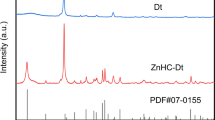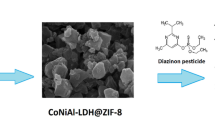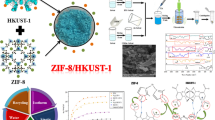Abstract
In recent years, excessive amounts of drugs such as antibiotics have been used to combat COVID-19 and newly discovered viruses. This has led to the production and release of significant amounts of drugs and their metabolites as toxic pollutants in aquatic systems. Therefore, pharmaceutical wastes must be removed efficiently before entering the environment and entering water sources. In this research, Ni/Al-LDH@ZIF-8 nanocomposite was synthesized from layered double hydroxides and metal-organic frameworks and used to remove the antibiotic sarafloxacin (SRF) in the aqueous medium. The work aimed to develop the performance and combine the features of the adsorbent compounds such as high surface area, adjustable porosity, and low-density structure. Different methods implemented to analyze the nanocomposite, such as Fourier transform infrared spectroscopy, X-ray diffraction, field emission scanning electron microscopy, and energy dispersive X-ray spectroscopy. The experiment utilized the central composite design to evaluate statistics and the response level method to optimize the factors affecting the absorption process. The initial concentration of SRF, adsorbent dose, pH, and contact time were considered in this experiment. The results showed an increase in the removal efficiency of SRF to 97%. Statistical studies showed that the optimal adsorption conditions are as follows: initial concentration of SRF 40 mg·L–1, pH 6.3, adsorbent dose of Ni/Al-LDH@ZIF-8 49 mg, and contact time of 44 min. According to the model of isotherms parameters, the adsorption process is more consistence with the Freundlich model with the absorption capacity of 79.7 mg·g−1. The pseudo-second-order model described the adsorption kinetics data.
Graphical abstract














Similar content being viewed by others
Data availability
Data sets generated and analyzed during the current study are available from the corresponding author upon request.
References
Heberer T. Occurrence, fate, and removal of pharmaceutical residues in the aquatic environment: a review of recent research data. Toxicol Lett. 2002;131(1–2):5–17.
Boxall AB. The environmental side effects of medication: how are human and veterinary medicines in soils and water bodies affecting human and environmental health? EMBO Rep. 2004;5(12):1110–6.
Halling-Sørensen BNNS, Nielsen SN, Lanzky PF, Ingerslev F, Lützhøft HH, Jørgensen SE. Occurrence, fate and effects of pharmaceutical substances in the environment-A review. Chemosphere. 1998;36(2):357–93.
Thiele-Bruhn S. Pharmaceutical antibiotic compounds in soils–a review. J Plant Nutr Soil Sci. 2003;166(2):145–67.
Citarasu T. Herbal biomedicines: a new opportunity for aquaculture industry. Aquacult Int. 2010;18(3):403–14.
Banerjee G, Ray AK. The advancement of probiotics research and its application in fish farming industries. Res Vet Sci. 2017;115:66–77.
Tamtam F, Mercier F, Le Bot B, Eurin J, Dinh QT, Clément M, Chevreuil M. Occurrence and fate of antibiotics in the Seine River in various hydrological conditions. Sci Total Environ. 2008;393(1):84–95.
Yuan SF, Liu ZH, Yin H, Dang Z, Wu PX, Zhu NW, Lin Z. Trace determination of sulfonamide antibiotics and their acetylated metabolites via SPE-LC-MS/MS in wastewater and insights from their occurrence in a municipal wastewater treatment plant. Sci Total Environ. 2019;653:815–21.
Kurt A, Mert BK, Özengin N, Sivrioğlu Ö, Yonar T. Treatment of antibiotics in wastewater using advanced oxidation processes (AOPs). Physico-chemical wastewater treatment and resource recovery. 2017;175.
Huang CH, Renew JE, Smeby KL, Pinkston K, Sedlak DL. Assessment of potential antibiotic contaminants in water and preliminary occurrence analysis. J Contemp Water Res Educ. 2011;120(1):4.
Anadón A, Suárez FH, Martínez MA, Castellano V, Martínez M, Ares I, Martínez-Larrañaga MR. Plasma disposition and tissue depletion of difloxacin and its metabolite sarafloxacin in the food producing animals, chickens for fattening. Food Chem Toxicol. 2011;49(2):441–9.
Jiménez-Lozano E, Marqués I, Barrón D, Beltrán JL, Barbosa J. Determination of pKa values of quinolones from mobility and spectroscopic data obtained by capillary electrophoresis and a diode array detector. Anal Chim Acta. 2002;464(1):37–45.
Alexy R, Kümpel T, Kümmerer K. Assessment of degradation of 18 antibiotics in the closed bottle test. Chemosphere. 2004;57(6):505–12.
Kümmerer K. Significance of antibiotics in the environment. J Antimicrob Chemother. 2003;52(1):5–7.
Yu R, Chen L, Shen R, Li P, Shi N. Quantification of ultratrace levels of fluoroquinolones in wastewater by molecularly imprinted solid phase extraction and liquid chromatography triple quadrupole mass. Environ Technol Innov. 2020;19: 100919.
Prabhakaran D, Sukul P, Lamshöft M, Maheswari MA, Zühlke S, Spiteller M. Photolysis of difloxacin and sarafloxacin in aqueous systems. Chemosphere. 2009;77(6):739–46.
Kusari S, Prabhakaran D, Lamshöft M, Spiteller M. In vitro residual anti-bacterial activity of difloxacin, sarafloxacin and their photoproducts after photolysis in water. Environ Pollut. 2009;157(10):2722–30.
Samadi-Maybodi A, Nikou M. Removal of sarafloxacin from aqueous solution by a magnetized metal-organic framework; Artificial neural network modeling. Polyhedron. 2020;179: 114342.
El-Azazy M, El-Shafie AS, Elgendy A, Issa AA, Al-Meer S, Al-Saad KA. A comparison between different agro-wastes and carbon nanotubes for removal of sarafloxacin from wastewater: kinetics and equilibrium studies. Molecules. 2020;25(22): 5429.
Huang X, Zheng J, Liu C, Liu L, Liu Y, Fan H. Removal of antibiotics and resistance genes from swine wastewater using vertical flow constructed wetlands: effect of hydraulic flow direction and substrate type. Chem Eng J. 2017;308:692–9.
Yang B, Meng L, Xue N. Removal of five fluoroquinolone antibiotics during broiler manure composting. Environ Technol. 2018;39(3):373–81.
Darweesh TM, Ahmed MJ. Adsorption of ciprofloxacin and norfloxacin from aqueous solution onto granular activated carbon in fixed bed column. Ecotoxicol Environ Saf. 2017;138:139–45.
Yan W, Zhang J, Jing C. Adsorption of Enrofloxacin on montmorillonite: two-dimensional correlation ATR/FTIR spectroscopy study. J Colloid Interface Sci. 2013;390(1):196–203.
Peng H, Pan B, Wu M, Liu Y, Zhang D, Xing B. Adsorption of ofloxacin and norfloxacin on carbon nanotubes: hydrophobicity-and structure-controlled process. J Hazard Mater. 2012;233:89–96.
Chen H, Gao B, Li H. Removal of sulfamethoxazole and ciprofloxacin from aqueous solutions by ZIF-8. J Hazard Mater. 2015;282:201–7.
Ötker HM, Akmehmet-Balcıoğlu I. Adsorption and degradation of enrofloxacin, a veterinary antibiotic on natural zeolite. J Hazard Mater. 2005;122(3):251–8.
Deng Y. Advanced oxidation processes (AOPs) for reduction of organic pollutants in landfill leachate: a review. Int J Environ Waste Manag. 2009;4(3–4):366–84.
Tiwari SC, Bhardwaj A, Nigam KDP, Pant KK, Upadhyayula S. A strategy of development and selection of absorbent for efficient CO2 capture: an overview of properties and performance. Process Saf Environ Prot. 2022;163:244–73.
Fernández A, Soriano E, López-Carballo G, Picouet P, Lloret E, Gavara R, Hernández-Muñoz P. Preservation of aseptic conditions in absorbent pads by using silver nanotechnology. Food Res Int. 2009;42(8):1105–12.
Kotp YH. Enhancement of industrial effluents quality by using nanocomposite Mg/Al LDH ultrafiltration membranes. J Inorg Organomet Polym Mater. 2020;30(12):5244–60.
Ramakrishna KR, Viraraghavan T. Dye removal using low cost adsorbents. Water Sci Technol. 1997;36(2–3):189–96.
Xia C, Huang H, Liang D, Xie Y, Kong F, Yang Q, Fu J, Dou Z, Zhang Q, Meng Z. Adsorption of tetracycline hydrochloride on layered double hydroxide loaded carbon nanotubes and site energy distribution analysis. Chem Eng J. 2022;443: 136398.
Gao J, Zheng X, Meng Z, Feng L. Adsorption of ciprofloxacin and tetracycline from wastewater by layered double hydroxides modified vermiculite. J Porous Mater. 2022;29(5):1299–308.
Halajnia A, Oustan S, Najafi N, Khataee AR, Lakzian A. Adsorption–desorption characteristics of nitrate, phosphate and sulfate on Mg–Al layered double hydroxide. Appl Clay Sci. 2013;80:305–12.
Morimoto K, Tamura K, Iyi N, Ye J, Yamada H. Adsorption and photodegradation properties of anionic dyes by layered double hydroxides. J Phys Chem Solids. 2011;72(9):1037–45.
Jawad A, Peng L, Liao Z, Zhou Z, Shahzad A, Ifthikar J, Zhao M, Chen Z, Chen Z. Selective removal of heavy metals by hydrotalcites as adsorbents in diverse wastewater: different intercalated anions with different mechanisms. J Clean Prod. 2019;211:1112–26.
Chen S, Huang Y, Han X, Wu Z, Lai C, Wang J, Deng Q, Zeng Z, Deng S. Simultaneous and efficient removal of cr (VI) and methyl orange on LDHs decorated porous carbons. Chem Eng J. 2018;352:306–15.
Wang X, Zhou W, Wang C, Chen Z. Cotton fiber-supported layered double hydroxides for the highly efficient adsorption of anionic organic pollutants in water. New J Chem. 2018;42(12):9463–71.
Wang Y, Zhang L. Improved performance of 3D hierarchical NiAl-LDHs micro-flowers via a surface anchored ZIF-8 for rapid multiple-pollutants simultaneous removal and residues monitoring. J Hazard Mater. 2020;395: 122635.
Sajid M, Basheer C, Daud M, Alsharaa A. Evaluation of layered double hydroxide/graphene hybrid as a sorbent in membrane-protected stir-bar supported micro-solid-phase extraction for determination of organochlorine pesticides in urine samples. J Chromatogr A. 2017;1489:1–8.
Zaghouane-Boudiaf H, Boutahala M, Tiar C, Arab L, Garin F. Treatment of 2, 4, 5-trichlorophenol by MgAl–SDBS organo-layered double hydroxides: kinetic and equilibrium studies. Chem Eng J. 2011;173(1):36–41.
Niknam Shahrak M, Ghahramaninezhad M, Eydifarash M. Zeolitic imidazolate framework-8 for efficient adsorption and removal of cr (VI) ions from aqueous solution. Environ Sci Pollut Res. 2017;24(10):9624–34.
Zhao Y, Pan Y, Liu W, Zhang L. Removal of heavy metal ions from aqueous solutions by adsorption onto ZIF-8 nanocrystals. Chem Lett. 2015;44(6):758–60.
Zhang Y, Xie Z, Wang Z, Feng X, Wang Y, Wu A. Unveiling the adsorption mechanism of zeolitic imidazolate framework-8 with high efficiency for removal of copper ions from aqueous solutions. Dalton Trans. 2016;45(32):12653–60.
Awadallah-F A, Hillman F, Al-Muhtaseb SA, Jeong HK. On the nanogate-opening pressures of copper-doped zeolitic imidazolate framework ZIF-8 for the adsorption of propane, propylene, isobutane, and n-butane. J Mater Sci. 2019;54:5513–27.
Troyano J, Carné-Sánchez A, Avci C, Imaz I, Maspoch D. Colloidal metal–organic framework particles: the pioneering case of ZIF-8. Chem Soc Rev. 2019;48(23):5534–46.
Khan NA, Jung BK, Hasan Z, Jhung SH. Adsorption and removal of phthalic acid and diethyl phthalate from water with zeolitic imidazolate and metal–organic frameworks. J Hazard Mater. 2015;282:194–200.
Jiang JQ, Yang CX, Yan XP. Zeolitic imidazolate framework-8 for fast adsorption and removal of benzotriazoles from aqueous solution. ACS Appl Mater Interfaces. 2013;5(19):9837–42.
Al-Hazmi GH, Adam AMA, El-Desouky MG, El-Bindary AA, Alsuhaibani AM, Refat MS. Efficient adsorption of rhodamine B using a composite of Fe3O4@ zif-8: synthesis, characterization, modeling analysis, statistical physics and mechanism of interaction. Bull Chem Soc Ethiop. 2023;37(1):211–29.
Kurt A, Mert BK, Özengin N, Sivrioğlu Ö, Yonar T. Treatment of antibiotics in wastewater using advanced oxidation processes (AOPs). Physico-chemical wastewater treatment and resource recovery. 2017;175
Dicker MP, Duckworth PF, Baker AB, Francois G, Hazzard MK, Weaver PM. Green composites: a review of material attributes and complementary applications. Compos Part A: Appl Sci Manufac. 2014;56:280–9.
Liu Y, Pang H, Wang X, Yu S, Chen Z, Zhang P, Chen L, Song G, Alharbi NS, Rabah SO, Wang X. Zeolitic imidazolate framework-based nanomaterials for the capture of heavy metal ions and radionuclides: a review. Chem Eng J. 2021;406: 127139.
Hu M, Lou H, Yan X, Hu X, Feng R, Zhou M. In-situ fabrication of ZIF-8 decorated layered double oxides for adsorption and photocatalytic degradation of methylene blue. Microporous Mesoporous Mater. 2018;271:68–72.
Khabazipour M, Anbia M. Process optimization and adsorption modeling using hierarchical ZIF-8 modified with lanthanum and copper for sulfate uptake from aqueous solution: kinetic, isotherm and thermodynamic studies. J Inorg Organomet Polym Mater. 2021;31(6):2401–24.
Yuan X, Wei Z, Zhang Z, Liu H. Hierarchical coating nanoarchitectonics of Halloysite Nanotube with polydopamine and ZIF-8 for Adsorption of Organic contaminants. J Inorg Organomet Polym Mater 1–10, (2022).
Song P, Tu Y, Shen X, Yuan A, Zhai L, Shah SA. Fabrication of ZIF-8@ SF Linear Composite through directly feeding approach. J Inorg Organomet Polym Mater. 2019;29(6):2083–9.
Samadi-Maybodi A, Ghezel-Sofla H, BiParva P. Co/Ni/Al-LTH layered triple hydroxides with zeolitic imidazolate frameworks (ZIF-8) as high efficient removal of diazinon from aqueous solution. J Inorg Organomet Polym Mater. 2023;33(1):10–29.
Cravillon J, Nayuk R, Springer S, Feldhoff A, Huber K, Wiebcke M. Controlling zeolitic imidazolate framework nano-and microcrystal formation: insight into crystal growth by time-resolved in situ static light scattering. Chem Mater. 2011;23(8):2130–41.
Şentürk İ, Alzein M. Adsorptive removal of basic blue 41 using pistachio shell adsorbent-performance in batch and column system. Sustainable Chem Pharm. 2020;16: 100254.
Mohammadi SZ, Safari Z, Madady N. Synthesis of Co3O4@ SiO2 core/shell–nylon 6 magnetic nanocomposite as an adsorbent for removal of Congo red from wastewater. J Inorg Organomet Polym Mater. 2020;30(8):3199–212.
Dinari M, Roghani N. Calcium iron layered double hydroxide/poly (vinyl chloride) nanocomposites: synthesis, characterization and Cd2 + removal behavior. J Inorg Organomet Polym Mater. 2020;30(3):808–19.
Nikou M, Samadi-Maybodi A. Application of chemometrics into simultaneous monitoring removal efficiency of two food dyes by an amine-functionalized metal–organic framework. J Iran Chem Soc. 2020;17(7):1671–93.
Guo Y, Zhu Z, Qiu Y, Zhao J. Adsorption of arsenate on Cu/Mg/Fe/La layered double hydroxide from aqueous solutions. J Hazard Mater. 2012;239:279–88.
Hassan N, Shahat A, El-Didamony A, El-Desouky M, El-Bindary AA. Equilibrium, kinetic and thermodynamic studies of adsorption of cationic dyes from aqueous solution using ZIF-8. Moroccan J Chem. 2020;8(3):8–3.
Kefif F, Ezziane K, Bahmani A, Bettahar N, Mayouf S. Evans Blue dye removal from contaminated water on calcined and uncalcined Cu-Al-CO _ 3 Cu-Al-CO 3 layered double hydroxide materials prepared by coprecipitation. Bull Mater Sci. 2019;42:1–11.
Abdi J, Vossoughi M, Mahmoodi NM, Alemzadeh I. Synthesis of metal-organic framework hybrid nanocomposites based on GO and CNT with high adsorption capacity for dye removal. Chem Eng J. 2017;326:1145–58.
Pourfaraj R, Kazemi SY, Fatemi SJ, Biparva P. α-and β-CoNi binary hydroxides nanostructures: synthesis, characterization, and application as heterogeneous catalysts. J Solid State Chem. 2018;265:248–56.
Nakagawa S, Cuthill IC. Effect size, confidence interval and statistical significance: a practical guide for biologists. Biol Rev. 2007;82(4):591–605.
Babić S, Horvat AJ, Pavlović DM, Kaštelan-Macan M. Determination of pKa values of active pharmaceutical ingredients. TRAC Trends Anal Chem. 2007;26(11):1043–61.
Rahman N, Haseen U. Equilibrium modeling, kinetic, and thermodynamic studies on adsorption of pb(II) by a hybrid inorganic–organic material: polyacrylamide zirconium(IV) iodate. Ind Eng Chem Res. 2014;53(19):8198–207.
Fu H, Li X, Wang J, Lin P, Chen C, Zhang X, Suffet IM. Activated carbon adsorption of quinolone antibiotics in water: performance, mechanism, and modeling. J Environ Sci. 2017;56:145–52.
Tan F, Liu M, Ren S. Preparation of polydopamine-coated graphene oxide/Fe3O4 imprinted nanoparticles for selective removal of fluoroquinolone antibiotics in water. Sci Rep. 2017;7(1):5735.
Tan F, Sun D, Gao J, Zhao Q, Wang X, Teng F, Quan X, Chen J. Preparation of molecularly imprinted polymer nanoparticles for selective removal of fluoroquinolone antibiotics in aqueous solution. J Hazard Mater. 2013;244:750–7.
Funding
The authors declare that no funds, grants, or other support were received during the preparation of this manuscript.
Author information
Authors and Affiliations
Contributions
All authors contributed to the study’s conception and design. Material preparation, data collection, and analysis were performed by [Abdolraouf Samadi-Maybodi] and [Sahar Abaskhani-Davanlo]. The first draft of the manuscript was written by [Sahar Abaskhani-Davanlo] and all authors commented on previous versions of the manuscript. All authors read and approved the final manuscript.
Corresponding author
Ethics declarations
This section does not apply to our manuscript and is not applicable.
Consent to participate
All the authors whose names are mentioned in the submitted article have contributed significantly to the concept of the work and contributed to the drafting and approval of the published version. They also agree to all aspects of the work in ensuring the accuracy of every part of the work. -
Competing interests
No potential competing interest was reported by the authors.
Additional information
Publisher’s Note
Springer Nature remains neutral with regard to jurisdictional claims in published maps and institutional affiliations.
Rights and permissions
Springer Nature or its licensor (e.g. a society or other partner) holds exclusive rights to this article under a publishing agreement with the author(s) or other rightsholder(s); author self-archiving of the accepted manuscript version of this article is solely governed by the terms of such publishing agreement and applicable law.
About this article
Cite this article
Abaskhani Davanlo, S., Samadi-Maybodi, A. Removal of sarafloxacin from aqueous solution through Ni/Al-layered double hydroxide@ZIF-8. J Environ Health Sci Engineer (2024). https://doi.org/10.1007/s40201-024-00891-4
Received:
Accepted:
Published:
DOI: https://doi.org/10.1007/s40201-024-00891-4




